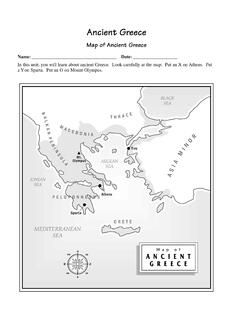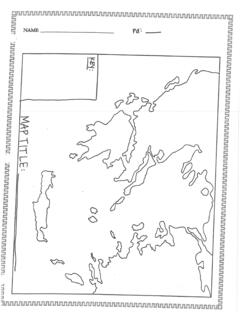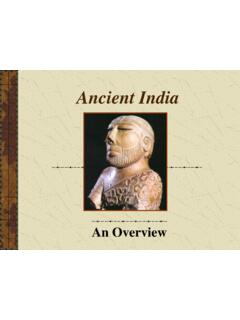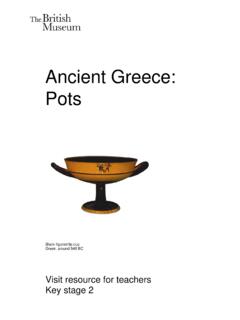Transcription of Ancient Egypt - The University of New Mexico
1 1) Course Introduction and Brief History of Ancient Egypt . Mohamed Ali. A series of select readings provide background on why Egypt has always played a pivotal leadership role in the region. This includes Egypt s movement from a historical position of regional dominance, to being under the influence of European and Russian powers, to once again becoming a regional power. (Oct 21) Ancient Egypt Overview The basic element in the lengthy history of egyptian civilization is geography. The Nile River rises from the lakes of central Africa as the White Nile and from the mountains of Ethiopia as the Blue Nile. The White and Blue Nile meet at Khartoum and flow together northward to the Nile delta, where the 4000 mile course of this river spills into the Mediterranean Sea (see map).
2 Less than two inches of rain per year falls in the delta and rain is relatively unknown in other parts of Egypt . Most of the land is uninhabitable. These geographical factors have determined the character of egyptian civilization. People could farm only along the banks of the Nile, where arid sand meets the fertile soil. Of course, each summer the Nile swells as the rains pour down and the snow melts on the mountains. The river overflows its banks and floods the land with fresh water and deposits a thick layer of rich alluvial soil. The land would then yield two harvests before winter. This yearly flood determined more than just the agricultural needs of early Egypt .
3 It also determined the lifecycle of society and helped to create the world view of Ancient egyptian civilization. The basic source of egyptian history is a list of rulers compiled in by Manetho for the Macedonians who ruled Egypt . Manetho divided egyptian kings into thirty dynasties (a 31st was added later) in the following manner. NAME DYNASTY YEARS Archaic Period 1-2 3100-2700 Old Kingdom 3-6 2700-2200 Intermediate Period 7-10 2200-2050 Middle Kingdom 11-12 2050-1800 Intermediate Period 13-17 1800-1570 New Kingdom 18-20 1570-1085 Post-Empire 21-31 1085-332 Early Egypt was divided into two kingdoms, one in Upper Egypt (Nile Valley), and one in Lower Egypt (Nile delta).
4 Remember, the Nile flows from south to north. egyptian Dynasties Menes (or Narmer) unified Upper and Lower Egypt and established his capital at Memphis around 3000 By the time of the Old Kingdom, the land had been consolidated under the central power of a king, who was also the "owner" of all Egypt . Considered to be divine, he stood above the priests and was the only individual who had direct contact with the gods. The economy was a royal monopoly and so there was no word in egyptian for "trader." Under the king was a carefully graded hierarchy of officials, ranging from the governors of provinces down through local mayors and tax collectors. The entire system was supported by the work of slaves, peasants and artisans.
5 The Old Kingdom reached its highest stage of development in the Fourth Dynasty. The most tangible symbols of this period of greatness are the three enormous pyramids built as the tombs of kings at Giza between 2600 and 2500. The largest, Khufu (called Cheops by the Greeks), was originally 481 feet high and 756 feet long on each side. Khufu was made up of million stone blocks averaging tons each. In the 5th century the Greek historian Herodotus tells us that the pyramid took 100,000 men and twenty years to build. The pyramids are remarkable not only for their technical engineering expertise, but also for what they tell us about royal power at the time.
6 They are evidence that egyptian kings had enormous wealth as well as the power to concentrate so much energy on a personal project. The priests, an important body within the ruling caste, were a social force working to modify the king's supremacy. Yielding to the demands of the priests of Re, a sun god, kings began to call themselves "sons of Re," adding his name as a suffix to their own. Re was also worshipped in temples that were sometimes larger than the pyramids of later kings. In the Old Kingdom, royal power was absolute. The pharaoh (the term originally meant "great house" or "palace"), governed his kingdom through his family and appointed officials.
7 The lives of the peasants and artisans was carefully regulated: their movement was limited and they were taxed heavily. Luxury accompanied the pharaoh in life and in death and he was raised to an exalted level by his people. The Egyptians worked for the pharaoh and obeyed him because he was a living god on whom the entire fabric of social life depended. No codes of law were needed since the pharaoh was the direct source of all law. In such a world , government was merely one aspect of religion and religion dominated egyptian life. The gods of Egypt came in many forms: animals, humans and natural forces. Over time, Re, the sun god, came to assume a dominant place in egyptian religion.
8 The Egyptians had a very clear idea of the afterlife. They took great care to bury their dead according to convention and supplied the grave with things that the departed would need for a pleasant life after death. The pharaoh and some nobles had their bodies preserved in a process of mummification. Their tombs were decorated with paintings, food was provided at burial and after. Some tombs even included full sized sailing vessels for the voyage to heaven and beyond. At first, only pharaohs were thought to achieve eternal life, however, nobles were eventually included, and finally all Egyptians could hope for immortality. The Egyptians also developed a system of writing.
9 Although the idea may have come from Mesopotamia, the script was independent of the cuneiform. egyptian writing began as pictographic and was later combined with sound signs to produce a difficult and complicated script that the Greeks called hieroglyphics ("sacred carvings"). Though much of what we have today is preserved on wall paintings and carvings, most of egyptian writing was done with pen and ink on fine paper (papyrus). In 1798 Napoleon invaded Egypt as part of his Grand Empire. He brought with a Commission of Science and Arts composed of more than one hundred scientists, engineers and mathematicians. In 1799 the Commission discovered a basalt fragment on the west bank of the Nile at Rachid.
10 The fragment is now known by its English name, the Rosetta Stone. The egyptian hieroglyphics found on the Rosetta Stone were eventually deciphered in 1822 by Jean Fran ois Champollion (1790-1832), a French scholar who had mastered Latin, Greek, Hebrew, Syriac, Ethiopic, Arabic, Persian, Sanskrit and Coptic. The Rosetta Stone contains three inscriptions. The uppermost is written in hieroglyphics; the second in what is now called demotic, the common script of Ancient Egypt ; and the third in Greek. Champollion guessed that the three inscriptions contained the same text and so he spent the next fourteen years (1808-1822) working from the Greek to the demotic and finally to the hieroglyphics until he had deciphered the whole text.








